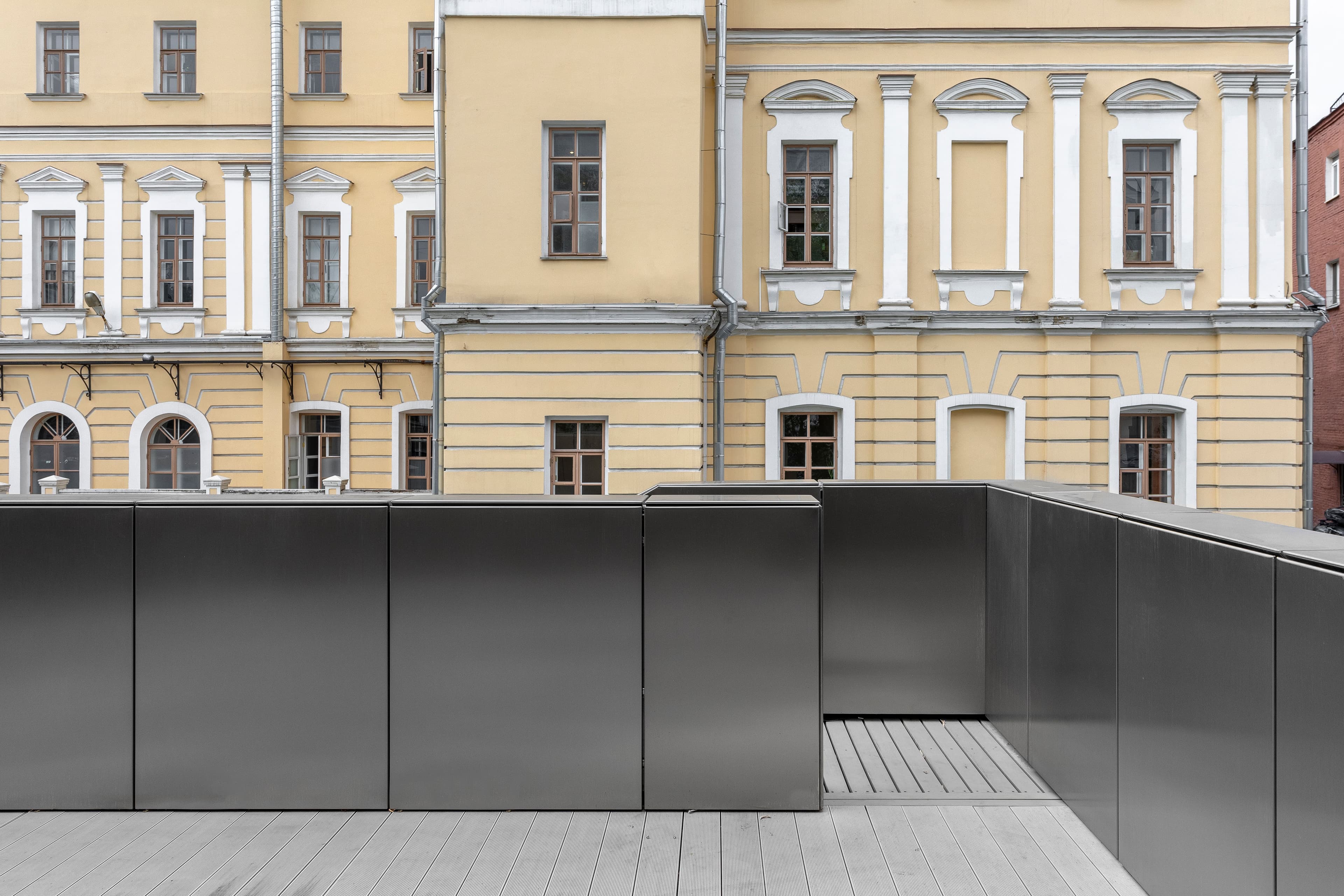GITIS
Stainless steel pavilions
Public space, Pavilion
Russia, Moscow, Maly Kislovsky lane, 6
2018-2021
Realized
Stanislav Kozeen, Azamat Nyrov
Russian Institute of Theatre Arts - GITIS
Polina Poludkina
Renovated Space of the Courtyard of GITIS Theatre Institute
Theatre is a place of freedom, and in order to give the students of GITIS more space for creative work and self-expression we cleared out the courtyard of the main building in Kislovsky Lane from dilapidated sheds and garages and turned it into a theatre square with for performances and rehearsals. One can watch what is going on in the square both sitting in the amphitheatre and looking from the windows of the Institute building.
The performance props, which the students make themselves, had been previously stored in the garage but now they are moved to a storage room with panoramic windows that we designed. It can serve as a museum of theatrical artefacts, or it can be used as workshops or classrooms. This pavilion serves as an architectural boundary of the inner courtyard, closing it off from the outside world and forming a chambered area-lounge. The upper part of the pavilion can be used as a balcony for viewing the performances or a space for outdoor rehearsals and scenario readings, where several groups of students can be accommodated without disturbing each other. The complex shape of the structure «circumvents» the trees growing in the courtyard, resulting in several secret gardens for enjoying solitude or private conversations.
The brick ruin of the former horse stable has been replaced by a dance pavilion. While the height, width, and proportions of the building were preserved, the basement discovered during demolition allowed the pavilion to have 4-metre ceilings so that students could perform complex acrobatic moves and supports. With this solution the floor of the dance hall happened to be below ground level, which is atypical for such spaces and creates an interesting spatial experience for dancers and an unusual angle for those watching rehearsals from outside.
Different functional zones of the theatre square are highlighted by the paving pattern, the paving also helps to separate the courtyard from the roadway. The spatial organisation of the new buildings in the courtyard and the neutral materials of which they are made — mainly stainless steel and glass — create a coherence and continuity of space and time, expressed in the harmonious layering of the several architectural styles of the Institute buildings.
Renovated Space of the Courtyard of GITIS Theatre Institute
Theatre is a place of freedom, and in order to give the students of GITIS more space for creative work and self-expression we cleared out the courtyard of the main building in Kislovsky Lane from dilapidated sheds and garages and turned it into a theatre square with for performances and rehearsals. One can watch what is going on in the square both sitting in the amphitheatre and looking from the windows of the Institute building.
The performance props, which the students make themselves, had been previously stored in the garage but now they are moved to a storage room with panoramic windows that we designed. It can serve as a museum of theatrical artefacts, or it can be used as workshops or classrooms. This pavilion serves as an architectural boundary of the inner courtyard, closing it off from the outside world and forming a chambered area-lounge. The upper part of the pavilion can be used as a balcony for viewing the performances or a space for outdoor rehearsals and scenario readings, where several groups of students can be accommodated without disturbing each other. The complex shape of the structure «circumvents» the trees growing in the courtyard, resulting in several secret gardens for enjoying solitude or private conversations.
The brick ruin of the former horse stable has been replaced by a dance pavilion. While the height, width, and proportions of the building were preserved, the basement discovered during demolition allowed the pavilion to have 4-metre ceilings so that students could perform complex acrobatic moves and supports. With this solution the floor of the dance hall happened to be below ground level, which is atypical for such spaces and creates an interesting spatial experience for dancers and an unusual angle for those watching rehearsals from outside.
Different functional zones of the theatre square are highlighted by the paving pattern, the paving also helps to separate the courtyard from the roadway. The spatial organisation of the new buildings in the courtyard and the neutral materials of which they are made — mainly stainless steel and glass — create a coherence and continuity of space and time, expressed in the harmonious layering of the several architectural styles of the Institute buildings.
